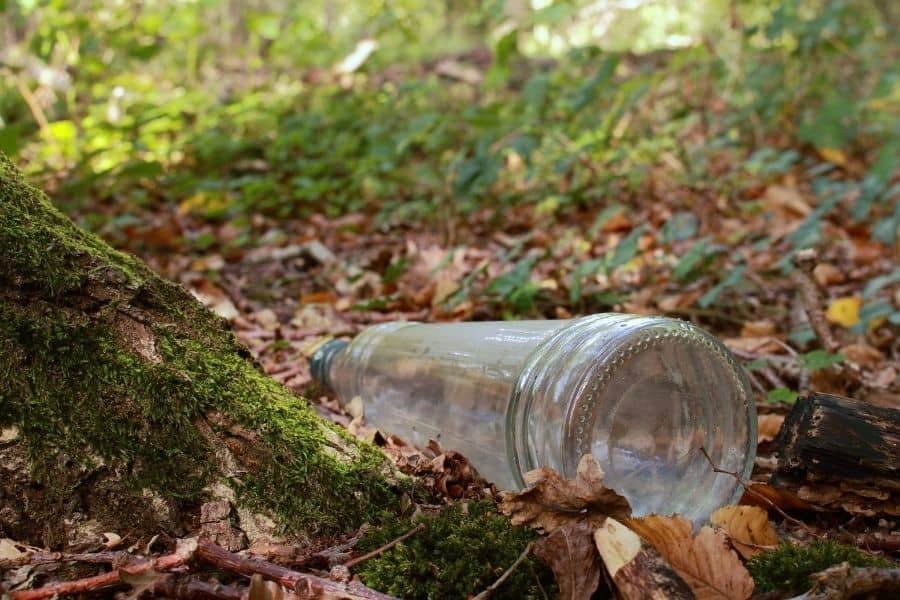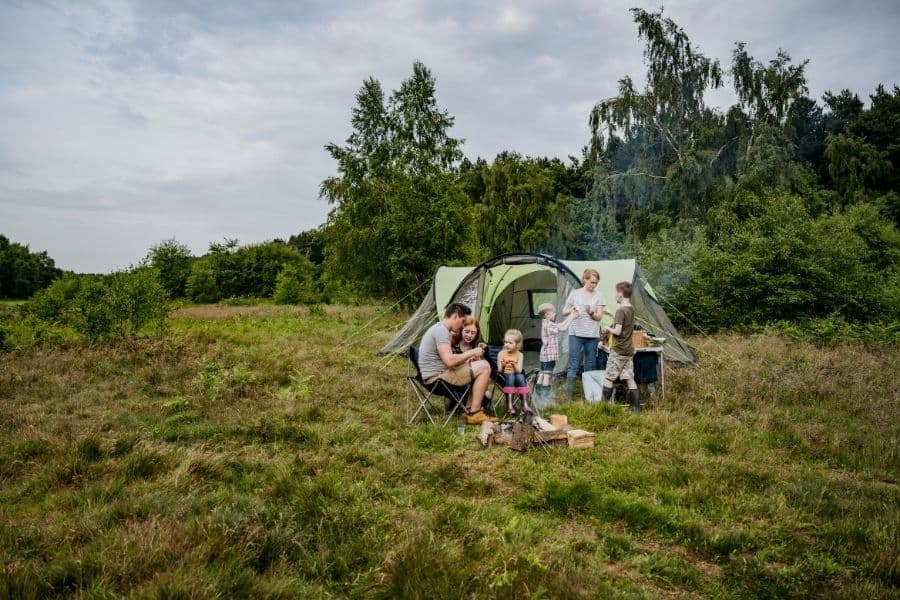Camping is a great way to escape the stress of everyday life and enjoy nature. But while we benefit from being outdoors, the environment doesn’t benefit from our presence.
In fact, our reckless actions often have negative effects on nature and its inhabitants.
But it doesn’t have to be that way. You can enjoy the outdoors without leaving your trace. What I’m talking about is eco camping, and in this article, we’ll go over everything you should know before your next trip.
Let’s jump straight in!
What Is Eco Camping?

Whether you call it eco, sustainable or zero waste camping, it means one thing – appreciating nature and its inhabitants by minimizing our impact on it. This includes not only how to behave but also what to bring and even how to get to the campsite.
Now, we all know better than to start a wildfire, but many campers aren’t aware of the waste they leave behind.
You might be thinking that a single banana peel thrown in the bush won’t make much difference. But when everyone thinks that way, our impact becomes huge.
Here’s what I’m talking about. After months of lockdowns and quarantines caused by the pandemic, everyone just wanted to go out. According to the statistics, around 48 million households went camping during 2020. But what’s even more shocking is that ⅕ are first-time campers!
With so many people out in the wild, we can safely assume that at least 5% of them will leave their impact on the environment – whether it’s leaving trash, driving vehicles off-road or simply scaring away wildlife.
While 5% sounds negligent, when you turn it into numbers, that’s over 2 million people! Now, don’t get me wrong. It’s great that so many people enjoy spending time outdoors. But in order to protect nature, we all should be eco camping.
Difference Between Eco Camping And Regular Camping
Anyone can camp. But it takes a specific mindset to do it environmentally friendly. This means thinking about the effects of your actions before doing them.
Not going to lie, eco camping can be challenging at first. But don’t worry, no one expects you to be an expert. Sustainable habits take time and planning, but every little effort counts.
The Benefits Of Eco Camping

Minimize The Impact On The Environment
With so many people hitting the outdoors, we’ve seen some horrible ways human presence has left an impact on nature. But if you stick to eco camping practices, you can enjoy the wilderness and preserve it at the same time.
By minimizing our impact on nature, we’re ensuring future generations can enjoy it as well.
Promote Environmental Conservation
The more time we spend out in the wild and away from busy city life, the more we can understand how precious nature is.
After seeing the devastating consequences our actions have had on nature, it’s clear we can’t stay blind to that. The principles and practices of eco camping are focused on keeping the environment in its pristine form.
Reduce Greenhouse Gasses
No matter where you’re traveling, you’ll probably use some way of transportation to get from place to place. But planes, cars and trains all emit gasses that pollute our air.
Camping near your home means using little, if any, transportation methods that emit greenhouse gasses.
Even if you’re camping in a distant location, you’ll only need a ride to and from the place. From there, you can explore the outdoors by hiking, kayaking, biking or any other gas-free activity.
Find More Wildlife Spotting Opportunities

Camping at a popular campground won’t give you plenty of opportunities to spot wildlife. Most animals tend to avoid places swarmed with people. But if you choose a more secluded location, you can catch a glimpse of some amazing animals around you.
Save Money
Camping is one of the cheapest vacation options out there. But eco camping goes even further.
Aside from not paying tons of money on rentals, you also save money by using reusables and borrowing or renting pieces of gear.
Social Impacts
Even a single weekend in the wilderness can give you a well-needed break from all those superficial things that bother us on an everyday basis. If only for a little bit, we can all forget our troubles and be one with nature.
Economic Impacts
Even camping, an outdoor activity, has fallen victim to consumerism. The market is swarmed with fancy camping gear and accessories we’re convinced we need. Eco camping promotes expense reduction by encouraging the three R’s – reusing, reducing and recycling.
Tips For Sustainable Camping

So we’re clear on how sustainable camping benefits the environment. But how actually should we leave no impact? Here are some tips that will help you make a difference.
Avoid Crowded State Parks And National Parks
Too many people in the same area negatively affect the environment in many ways, including soil damage and noise pollution. That’s why you should avoid popular camping locations altogether. Instead, choose a less explored area. Or go wild camping.
Camp In The Off-Season
If you’re set on a popular destination, the best way to avoid the crowd is to go there in the off-season.
Likewise, campsites are generally less booked during weekdays compared to weekends. You can check out the best time to go camping in your are here.
Minimize Transportation Needs

Transportation is an important part of your camping trip. To stay environmentally friendly, try reducing your gas emissions as much as possible. One way to do that is by carpooling to a camping location.
Another option is to take public transportation to the campsite. If the bus is going to the same location anyway, why also spend gas and pollute the air by driving there?
Finally, you can minimize transportation needs by simply camping close to your home. I’m sure there’s a great camping spot just a short walk or bike ride away.
Pack Sustainable Items Only
Sustainable camping requires a bit of planning, especially when it comes to what to bring on your trip. Avoiding single-use plastic is a no brainer. In fact, you shouldn’t use plastic at all – the products aren’t very long-lasting, but the waste they leave behind is.
Instead, invest in high-quality reusable containers. Metal or silicon might weigh a bit more, but it can last you a pretty long time. Bamboo is another eco-friendly option worth considering.
From soaps and toothpaste to skincare and pest repellents, there are tons of chemical products you might need at a campsite. But you should make sure they contain no toxic ingredients that can mess with the biosphere in any way.
Borrow, Rent, Share Gear
If you’re camping for the first time, you can’t be absolutely sure you’ll enjoy it enough to repeat it.
So instead of buying things that will sit in your garage, borrow the equipment from your friend or rent it from the store. Then, if you decide on doing it regularly, you can invest in your own gear.
But don’t buy cheap equipment. If you need to buy a new tent every few years, it kills the whole purpose of sustainable camping. Instead, invest in high-quality gear that can endure quite some beating. You should also consider buying from brands that offer repair services. Most damage caused by wear and tear can easily be fixed.
Follow Leave No Trace Principles
As the name suggests, Leave No Trace principles give you a basic guideline on how to minimize your impact on the environment.
In other words, how to enjoy the outdoors without any proof of you being there – aside from casual footprints.
Learn Proper Waste Disposal

Waste is harmful to both flora and fauna. And I’m not just talking about trash. Greywater and our number 1s and 2s can contaminate the ecosystem with chemicals and pathogens. But while you can’t avoid creating waste altogether, there are eco-friendly ways you can dispose of it.
First, let’s talk about our “bathroom breaks.”
- Make sure you’re at least 200 feet from a water source before you find a location to “do it.”
- For number 2, the only right way to dispose of human waste is to bury it. That’s why having a trowel is a must. When you have to go, dig a hole that’s at least 6 inches deep and fill the hole with soil.
- As for toilet paper, it should never be buried but packed in a bag and bag and dumped in your toilet when you get back.
Greywater should be disposed of in the same manner.
- Dig a 6-inch hole away from the closest water source
- Pour greywater and fill again with soil.
- But prior to doing that, make sure to remove all food particles from the water, or animals following the scent might come visiting.
Finally, pick up every piece of trash after yourself. Make sure to pack enough garbage bags so that nothing is left behind.
To make things easier on yourself, you can purchase a collapsible trash can.
Build Responsible Campfires

Before setting up a campfire, get acquainted with rules and regulations in that specific area.
Some parks have year-round campfire bans. Others implement fire bans during the hottest and driest months of the year, when wildfires are most common.
If you’re allowed to build a campfire, make sure to always make a fire pit. This prevents the flames from going too wild and potentially igniting the whole forest.
Respect Wildlife
No matter how cute you might find them, keeping the distance between you and them is crucial for both yours and their safety.
That’s why it’s important to keep your campsite clean from any food leftovers. First, they might attract a bear, wolf or another potentially dangerous and hungry beast. At the same time, human food is unnatural and can make them sick.
Use only Existing Campsites
When picking the perfect camp spot, a few rules apply. If available, try using the same area someone already camped on before. Pitching a tent can damage the vegetation underneath, which takes a long time to grow back. What’s worse, repetitive damage can cause them to never grow back. So instead of setting up a tent on soft grass, choose a spot with visible tent pats.
Leave What You Find
Wildflowers are beautiful. But don’t pick them. If everyone would do that, there would be little flowers left to reproduce in the future. The same goes for trees – don’t cut off branches or carve your name into the trunk, you might kill it!
Sustainable Gear Suggestions

Did you know that textile production makes up 10% of carbon emissions? What’s more, it pollutes water sources and dries them up. Eco camping is all about using quality gear made of long-lasting materials, so there’s less waste.
The most sustainable option is, obviously, using what you already have. But in case you have to buy something, this section will cover some eco-friendly camping gear suggestions to consider.
Use Renewable Energy
It’s difficult, if not impossible, to avoid using electrical devices while on the trail. But what we can do is use renewable energy to power them. Solar flashlights and power banks are both great options that stay charged for quite a long time.
Sustainably Made And Eco Friendly
Nowadays, many brands are making sustainable lines of clothing or tuning eco-friendly altogether. They either use recycled materials or renewable fabrics (like polyester) to create products without damaging the environment.
Bluesign, Climate Neutral, B Corp and Forest Stewardship are just a few indicators that show a product was sustainably made.
88% – The percentage of polyester fabrics we made with recycled polyester this season. – Patagonia Recycled Polyester
REI, The North Face, Patagonia and Vango are just a few brands with lines of products made with recycled or responsibly-sourced fabrics.
Sleeping Bag
While a down sleeping bag is definitely warmer and lighter than a synthetic one, it definitely isn’t a more eco-friendly option.
Nowadays, you can find synthetic bag models made of recycled materials, such as plastic bottles. Check out The North Face Eco Trail Bed Sleeping Bag – What a great way to reuse unnecessary trash.
Clothing
Know how your clothes are made.
Nylon is another material that can be made from recycled sources, from fishnets to factory scraps.
Merino wool, a popular fabric for camping clothes, is renewable and recyclable. What’s even better is that it’s biodegradable! It naturally degrades in as little as four months, and since it contains keratin, it works as a fertilizer as well!
Also, shop only socially responsible outdoor clothing brands like Patagonia, The North Face Renew, Save The Duck, and REI
Tents
A tent is one of the most expensive pieces of camping equipment.
Eco-friendly tents can cost a pretty penny, but they will be well worth it in their longevity.
Take for instance canvas tents, which can last a lifetime. Canvas tent fabric is made from cotton. It is entirely biodegradable unlike other man-made tent materials.
If that’s too big of a splurge, another way to stay sustainable is to buy a pre-owned high-quality tent or borrowing from a friend.
Camp Kitchen Gear
You can find tons of plastic utensils and kitchenware on the market. And while they might cost a bit less at first, they’d never last you as long as metal would. Plus, they make them lightweight and stackable, so you can store them easily. I prefer stainless steel kitchenware, but if you want an even lighter option, go for aluminum when building your campfire cooking kit.
When it comes to camping stoves, liquid fuel is by far the most sustainable option. Unlike isobutane and butane canisters, liquid fuel can be refilled and reused.
But did you know that you can also refill your propane canisters with a propane tank? This makes propane the leading option for camping sustainability (and ease of use).
Hygiene Products
Most hygiene products we use at home aren’t eco-friendly. Luckily, biodegradable soaps and toothpaste can be found in supermarkets and drugstores.
Now, here’s something you might not be aware of – creams and ointments we use on our skin can also damage the environment. So don’t go swimming in a lake with your sunscreen on or after using the mosquito-repelling spray. You can endanger both the flora and fauna inside the water source.
Pros And Cons of Eco Camping

Once summed up, it’s clear that there are tons of advantages of sustainable camping. These include:
- Preserves the biodiversity
- Brings us closer to nature
- Conserves endangered wildlife
- Saves money in the long run
The disadvantages, on the other hand, are:
- Can be costly upfront
- Takes time to get used to
In Conclusion
Eco camping is all about enjoying nature and keeping it intact.
Just keep in mind that it’s a journey, not a race. Don’t be too hard on yourself for doing things differently in the past.
Now you know how to avoid leaving an impact, and in time, these tips will become your second nature.


